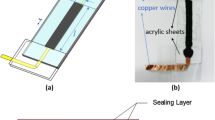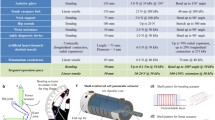Abstract
Motion capture of human body potentially holds great significance for exoskeleton robots, human-computer interaction, sports and rehabilitation research. Dielectric Elastomer Sensors (DESs) are excellent candidates for wearable human motion capture system because of their intrinsic characteristics of softness, lightweight and compliance. Fabrication process of the DES was developed, but a very few of optimal design is mentioned. To get greater measurement precision, in this paper, some optimization criteria was put forward and validated by some experiments. As a practical example, the sensor was mounted on the wrist to measure joint rotation. The experiment results indicated that there is a roughly linear relationship between the output voltage and the joint angle. Therefore, the DES can be applied to motion capture of human body.
Access this chapter
Tax calculation will be finalised at checkout
Purchases are for personal use only
Similar content being viewed by others
References
Goebl, W., Palmer, C.F.: Temporal control and hand movement efficiency in skilled music performance. PLoS ONE 8(1), 96–98 (2013)
Zhou, H., Stone, T., Hu, H., et al.: Use of multiple wearable inertial sensors in upper limb motion tracking. Med. Eng. Phys. 30(1), 123–133 (2008)
Zhou, H., Hu, H.F.: Inertial motion tracking of human arm movements in stroke rehabilitation. In: 2005 IEEE International Conference Mechatronics and Automation, vol. 3, pp. 1306–1311. IEEE (2005)
Mcgorry, R.W., Chang, C.C., Dempsey, P.G.F.: A technique for estimation of wrist angular displacement in radial/ulnar deviation and flexion/extension. Int. J. Ind. Ergon. 34(1), 21–29 (2004)
Kasahara, T., Mizushima, M., Shinohara, H., et al.: Simple and low-cost fabrication of flexible capacitive tactile sensors. Jpn. J. Appl. Phys. 50(1), 317–326 (2011)
Kim, D., Lee, C.H., Kim, B.C., et al.: Six-axis capacitive force/torque sensor based on dielectric elastomer. In: Proceedings of SPIE - The International Society for Optical Engineering, vol. 8687(3), 86872J (2013)
Böse, H., Fuß, E.F.: Novel dielectric elastomer sensors for compression load detection. In: Proceedings of SPIE - The International Society for Optical Engineering, vol. 9056, 905614 (2014)
Böse, H., Fuß, E., Lux, P.F.: Influence of design and material properties on the performance of dielectric elastomer compression sensors. In: Proceedings of SPIE - The International Society for Optical Engineering, vol. 9430, 943029 (2015)
Stretchsense Homepage. http://stretchsense.com. Accessed 31 May 2017
Jung, K., Kim, K.J., Choi, H.R.F.: A self-sensing dielectric elastomer actuator. Sens. Actuators A Phys. 143(2), 343–351 (2008)
Gisby, T.A., O’Brien, B.M., Anderson, I.A.F.: Self-sensing feedback for dielectric elastomer actuators. Appl. Phys. Lett. 102(19), 193703–193704 (2013)
Goulbourne, N.C., Son, S., Fox, J.W.F.: Self-sensing McKibben actuators using dielectric elastomer sensors. In: Proceedings of SPIE - The International Society for Optical Engineering, vol. 6524, 652414 (2007)
Matysek, M., Haus, H., Moessinger, H., et al.: Combined driving and sensing circuitry for dielectric elastomer actuators in mobile applications. In: Proceedings of SPIE - The International Society for Optical Engineering, vol. 7976(6), pp. 541–558 (2011)
O’Brien, B., Anderson, I., Calius, E.F.: Integrated extension sensor based on resistance and voltage measurement for a dielectric elastomer. In: Proceedings of SPIE - The International Society for Optical Engineering, vol. 6524(15), pp. 1–11 (2007)
Samuel, R., Araromi, O.A., Samuel, S., et al.: Fabrication process of silicone-based dielectric elastomer actuators. J. Visualized Exp. 108, e53423 (2016)
Araromi, O., Poulin, A., Rosset, S., et al.: Thin-film dielectric elastomer sensors to measure the contraction force of smooth muscle cells. In: Spie Smart Structures and Materials + Nondestructive Evaluation and Health Monitoring. International Society for Optics and Photonics, vol. 9430, 94300Z (2015)
Araromi, O.A., Rosset, S., Shea, H.R.F.: High-resolution, large-area fabrication of compliant electrodes via laser ablation for robust, stretchable dielectric elastomer actuators and sensors. ACS Appl. Mater. Interfaces 7(32), 18046–18053 (2015)
Acknowledgments
This work was supported by the National Natural Science Foundation of China (Grant No. 91648106), the Natural Science Foundation of Shandong Province (Grant No. ZR2016EEM16) and the Foundation of State Key Laboratory of Mechanical Strength and Vibration (Grant No. SV2016-KF-13).
Author information
Authors and Affiliations
Corresponding author
Editor information
Editors and Affiliations
Rights and permissions
Copyright information
© 2017 Springer International Publishing AG
About this paper
Cite this paper
Mei, T., Ge, Y., Zhao, Z., Li, M., Zhao, J. (2017). Optimal Design and Experiments of a Wearable Silicone Strain Sensor. In: Huang, Y., Wu, H., Liu, H., Yin, Z. (eds) Intelligent Robotics and Applications. ICIRA 2017. Lecture Notes in Computer Science(), vol 10464. Springer, Cham. https://doi.org/10.1007/978-3-319-65298-6_13
Download citation
DOI: https://doi.org/10.1007/978-3-319-65298-6_13
Published:
Publisher Name: Springer, Cham
Print ISBN: 978-3-319-65297-9
Online ISBN: 978-3-319-65298-6
eBook Packages: Computer ScienceComputer Science (R0)




